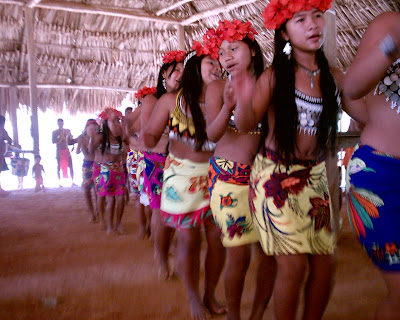My sister, Barbara, and I took a day tour from Panama City to visit an Embera village established approximately 60 years ago along the mouth of the Chagres River not far from the canal. It's a small community that continues to struggle against the effects of progress and modern civilization. Solar panels seen in the above photo, however, are examples of one beneficial influence brought in from the outside world.
The village has been adversely impacted by regulations against farming, hunting, and fishing that went into effect when the area was converted into a national park. The government provides some educational and economic assistance, though, to help the community convert from their traditional lifestyle into a current adaptation brought about by forced tourism and the sale of artesan products.
Our guide relayed that the transition has not been an easy one. The community was reportedly better off living in their traditional manner. Present day sales from baskets, beading, and carved items drops during the low season, and even the income earned during high season is insufficient to support the community's needs. Product pricing is marketed as reflecting one dollar for each day's toil. In other words, an article priced at $20 supposedly reflects twenty days of Indian labor to produce.
Prices charged in the village were significantly lower than similar items seen later in Panama City markets and souvenier shops. I regretted not having purchased more items during the trip. The villagers admited, however, that many of the materials used in their modern day crafts are purchased in Panama City, as opposed to being obtained and prepared from plants and vegetation in the surrounding environment. A matter of convenience as much as environmental preservation, I suppose...
The village spokesman told us they continue to employ their own health care practices, utilizing botanicals and traditional medicine. But they also have access to public health care in Panama City, and do utilize these resources at times.
Traditional dance is supported by male musicians who play flutes, tortoise-shell drums, and sing and chant. The women of the village dance in lines that circle, with movements representing animals, such as hummingbirds and monkeys.
Transportation is by dugout canoes utilizing power motors, and then by public buses where roads exist.
It was more than an hour's drive from Panama City to the boat launch rendevous point, and then another 30 minute boat ride from point of embarkation to the actual village. The villagers were hardworking and friendly, and fed us a very tasty lunch of fried tilapia wrapped in banana leaves, accompanied by patacones and fruit. We were also taken to a remote spot where we treked a short distance to a refreshing waterfall with a deep natural pool at it's base. There we were able to swim and cool off from the hot mid-day sun. It was a thoroughly enjoyable and unique way to spend the day.







